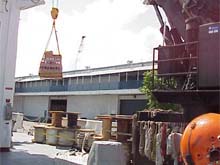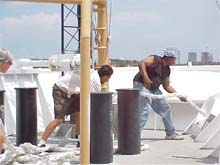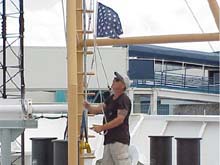
Bosun Bruce (left) with his deck crew Chris (middle) and Reggie (right) securing the anchor after we left the port of Miami. The anchor was held “at ready” in case of an emergency in shallow water. Upon hitting the open sea, the deck crew has to make sure that the anchor is locked in place. Click image for larger view.
Somewhere in the Atlantic…
August 28, 2002
Lisa M. Weiss, Watershed Coordinator
Jacques Cousteau National Estuarine Research Reserve
“…I undertook a journey of discovery beyond the blue horizon. I went to search out the oceans’ messages, and to bring those messages ashore. I traveled in a variety of roles: scientist, observer, advocate, guide, tourist, fisherman. The following pages record my journey. I will be your guide and interpreter. But ultimately you must judge what the oceans’ creatures and its peoples have to say, and what it means to you.” - Carl Safina: Song for the Blue Ocean
Day two of our 20-day journey has begun. We set out from the port of Miami about 1400 (2 pm) yesterday, one hour delayed because the ship's officers were waiting for a FedEx package. The package contained our ground positioning system (GPS) software, which is the electronic navigational chart by which the ship steers. An important package to have waited for! Yesterday in Miami was very hot, so we were not upset that as we got underway, we were greeted with a nice cooling breeze from the Atlantic.
Scientists hypothesize that the huge eyes of deep-sea benthic creatures are adapted for viewing bioluminescence. But little is known about bioluminescence on the deep-sea floor, and we know virtually nothing about the visual systems of these deep-sea inhabitants.

Food provisions being loaded on board from the port of Miami. The Hudson Exploration is scheduled for 20 days, so the galley staff has to make sure that they have loaded enough food on board for all the officers, crew and scientific community, for three meals a day.
As I explained in yesterday's log, there are many procedural operations that have to be completed before the Ron Brown is ready to be deployed. One important provision for the trip is food. When in port, the galley staff purchases enough food for the duration of the trip and has it delivered and loaded aboard. The food is loaded onto a palette and then brought aboard ship with a mechanical crane. The boxes then have to be manually carried to the galley storage and stowed until needed. It is not as easy as going to your local grocery store and picking up food you might need for dinner that night. The galley staff has to make sure that they are supplied for the length of the entire trip, and have a diversity of choices to keep everyone happy. When we were finally ready to shove off from the dock, the NOAA officers that are stationed in Miami took our lines off the dock, releasing the ship from its berth, while the Ron Brown's deck crew hauled in the slackened lines. The lines are cast off from the dock in a very coordinated fashion as the ship's engines move us away from the dock. The lines are then brought onto the deck, where they are stowed through a deck hatch into an out-of-the-way box below deck.

These specially designed traps isolate the shrimps and crabs inside from light and elevated water temperatures as they are brought to the surface. Click image for larger view.
As the final line is cast off the dock, there is the ceremonious “shifting of the colors.” This means that as the ship is finally released from its berth at the dock and the final line is cast off, the American flag that has been flying off the fantail of the ship is taken down, along with the small flag that has been flying up by the bow of the ship. The American flag is then brought to the top of the ship to fly while we are underway. All of these procedures are done simultaneously.
After we steamed out past South Beach, Miami, we went past a number of buoys that mark the channel leading to the port, and looked ahead to see only open ocean. When we pass the last buoy, this signifies that we have reached “open ocean,” and it is time to secure the anchor. Until we enter deep water, the anchor is held in a “ready” position in case of an emergency while we are steaming in the shallow water. Once into the deep waters of the ocean, the anchor can be “secured” because the fear of an emergency where the anchor would be necessary has passed. The Ron Brown is now ready for its three-day sail up to the Hudson Canyon, where we will begin our research.

A schematic drawing of the electrophysiology apparatus used to study the color and light sensitivity of deep sea benthic organisms. Click image for larger view.
As of this morning 0900 (9 am), we are still off the coast of Florida, about even with Jacksonville. We are following the Gulf Stream, relying on its speed and direction to assist us in our passage up North. We are making our way up the coast, and will follow the Gulf Stream with its path off the coast of North Carolina. Last night we watched lightening storms all around the ship, but saw only clear, star-filled skies above us. The first night of sleep while underway is the best, as the natural rocking motion of the ship helps to lull you into a deep sleep. Our weather and sea conditions have been favorable so far, which is helping me get my “sea legs.” So far so good, but I should be careful I don’t jinx myself. As a departing thought, try to imagine looking around yourself and seeing only water, 360 degrees around ... hard to imagine, but I can promise you that it is something that everyone should experience at least once in his or her life. It really is the only way to get a true sense, respect and appreciation for the vastness of the ocean.
Sign up for the Ocean Explorer E-mail Update List.























